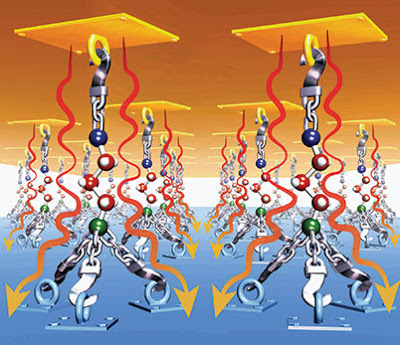A team of interdisciplinary researchers at Rensselaer Polytechnic Institute has developed a new method for significantly increasing the heat transfer rate across two different materials. Results of the team’s study, published in the journal Nature Materials, could enable new advances in cooling computer chips and lighting-emitting diode (LED) devices, collecting solar power, harvesting waste heat, and other applications.
By sandwiching a layer of ultrathin “nanoglue” between copper and silica, the research team demonstrated a four-fold increase in thermal conductance at the interface between the two materials. Less than a nanometer—or one billionth of a meter—thick, the nanoglue is a layer of molecules that form strong links with the copper (a metal) and the silica (a ceramic), which otherwise would not stick together well. This kind of nanomolecular locking improves adhesion, and also helps to sync up the vibrations of atoms that make up the two materials which, in turn, facilitates more efficient transport of heat particles called phonons. Beyond copper and silica, the research team has demonstrated their approach works with other metal-ceramic interfaces.
Heat transfer is a critical aspect of many different technologies. As computer chips grow smaller and more complex, manufacturers are constantly in search of new and better means for removing excess heat from semiconductor devices to boost reliability and performance. With photovoltaic devices, for example, better heat transfer leads to more efficient conversion of sunlight to electrical power. LED makers are also looking for ways to increase efficiency by reducing the percentage of input power lost as heat. Ganapati Ramanath, professor in the Department of Materials Science and Engineering at Rensselaer, who led the new study, said the ability to enhance and optimize interfacial thermal conductance should lead to new innovations in these and other applications.
“Interfaces between different materials are often heat-flow bottlenecks due to stifled phonon transport. Inserting a third material usually only makes things worse because of an additional interface created,” Ramanath said. “However, our method of introducing an ultrathin nanolayer of organic molecules that strongly bond with both the materials at the interface gives rise to multi-fold increases in interfacial thermal conductance, contrary to poor heat conduction seen at inorganic-organic interfaces. This method to tune thermal conductance by controlling adhesion using an organic nanolayer works for multiple materials systems, and offers a new means for atomic- and molecular-level manipulation of multiple properties at different types of materials interfaces. Also, it’s cool to be able to do this rather unobtrusively by the simple method of self-assembly of a single layer of molecules.”
If you liked this article, please give it a quick review on ycombinator or StumbleUpon. Thanks

Brian Wang is a Futurist Thought Leader and a popular Science blogger with 1 million readers per month. His blog Nextbigfuture.com is ranked #1 Science News Blog. It covers many disruptive technology and trends including Space, Robotics, Artificial Intelligence, Medicine, Anti-aging Biotechnology, and Nanotechnology.
Known for identifying cutting edge technologies, he is currently a Co-Founder of a startup and fundraiser for high potential early-stage companies. He is the Head of Research for Allocations for deep technology investments and an Angel Investor at Space Angels.
A frequent speaker at corporations, he has been a TEDx speaker, a Singularity University speaker and guest at numerous interviews for radio and podcasts. He is open to public speaking and advising engagements.


